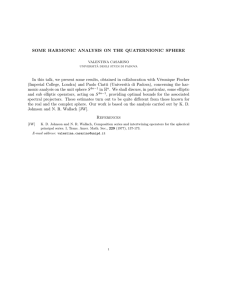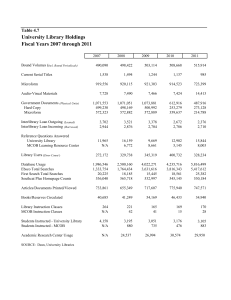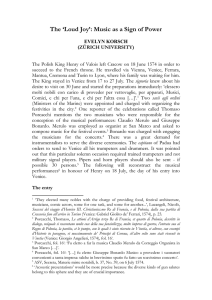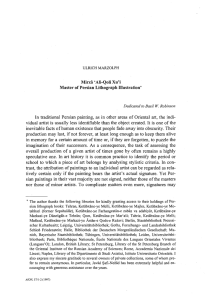‘An infinite sphere, whose centre is everywhere
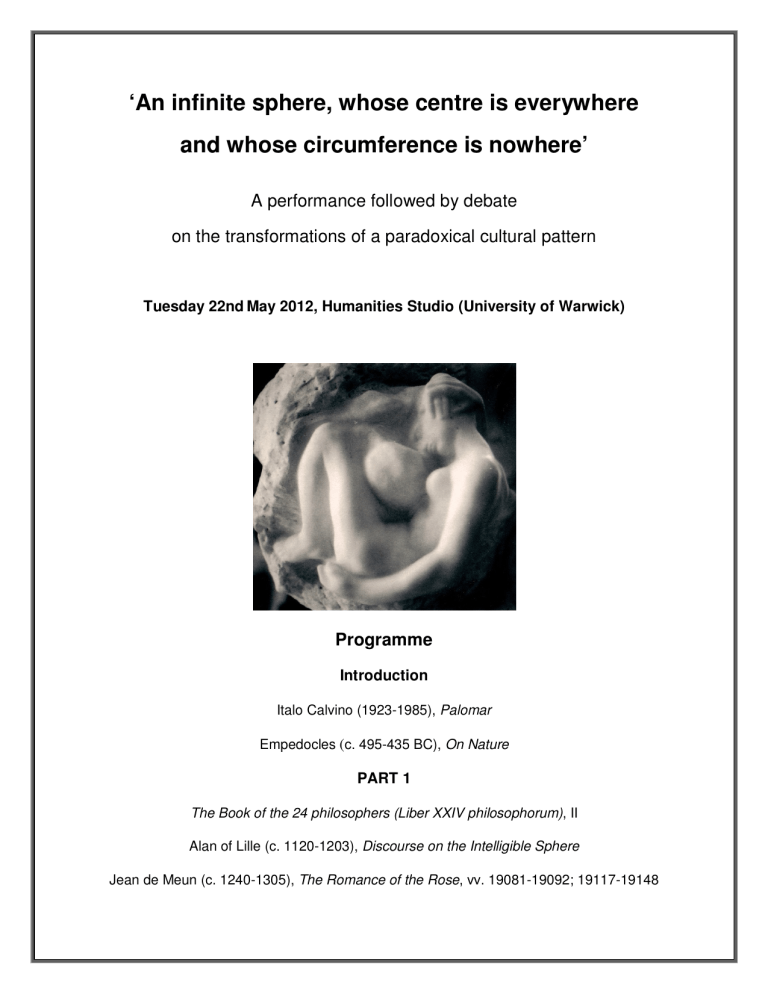
‘An infinite sphere, whose centre is everywhere and whose circumference is nowhere’
A performance followed by debate on the transformations of a paradoxical cultural pattern
Tuesday 22nd May 2012, Humanities Studio (University of Warwick)
Programme
Introduction
Italo Calvino (1923-1985), Palomar
Empedocles ( c. 495-435 BC), On Nature
PART 1
The Book of the 24 philosophers (Liber XXIV philosophorum) , II
Alan of Lille (c. 1120-1203), Discourse on the Intelligible Sphere
Jean de Meun (c. 1240-1305), The Romance of the Rose , vv. 19081-19092; 19117-19148
Dante (1265-1321), The Divine Comedy , Paradiso , Canto 33, vv. 58-75; 115-145
François Rabelais (c. 1483-1553), The Third Book of Pantagruel , 13; The Fifth Book of Pantagruel , 47
PART 2
Marsilio Ficino (1433-1499), Platonic Theology , XVII, 3
Nicholas of Cusa (1401-1464), On Learned Ignorance, II, 11-12
Giordano Bruno (1548-1600), On Cause Principle and Unity , Fifth dialogue
Images a) Auguste Rodin, The Hand of God, 1898. Rodin Museum, Paris b) Alighiero Boetti, Tutto , 1994. Museum für Moderne Knust, Frankfurt am Main c) The Lambeth Palace, or Reading, world map. Reading Abbey, ca. 1300. London, Lambeth Palace
Library, MS 371, fol. 9 v d) Spanish School, The Creation (tapestry), 12th century. Museo Capitular de la Catedral de Girona,
Catalonia, Spain e) Greek Evangelical School, The Creator and the Cosmos , formerly Smyrna [Izmir] MS A.1 (presumed destroyed in 1922) ca. 1125–55. After D.-C. Hesseling, Miniatures de l’octateuque grec de Smyrne
(Leiden, 1909) f) The opening of the Genesis from the first page of the Stavelot Bible. Stavelot, Mosan Valley (modern
Beligium), late 12th century. London, British Library, MS 28106, fol. 6r g) Matfre Ermengaud, Breviari d'Amor, France (Toulouse?), 14th century. London, British Library MS
Royal 19 C I, fol. 11v h) Book of Hours, Use of Sarum (The 'Neville of Hornby Hours') , England, (London?) 14th century.
London, British Library MS Egerton 2781, fol. 1v i) Sandro Botticelli, Drawing for the Divine Comedy , Ascent to the sphere of fixed stars by way of Jacob's ladder, ca. 1480-95. Berlin, Kupferstichkabinett i) Guiard des Moulins, Bible historiale , Paris, early 15th century. Paris, BNF, Manuscrits, Français 3, fol.
3v k) Gustave Doré, Par . XXXI, in Dante Alighieri, Le Purgatoire [et le Paradis] , traduction franc - (Paris, L.
Hachette et Cie., 1868) l) Cicero, Somnium Scipionis , with Macrobius' Commentary, Bologna, 1383. Oxford, Bodleain Library, Ms
Canon Clas Lat 257, fol. 4 m) Robert Fludd, The descent of the divine mind into the human body, in Utriusque Cosmi…Historia , ii,
Tract I (Oppenheim, J.T. de Bry, 1619) n) Petrus Apianus, Cosmographicus liber (Landshut , J. Weissenburger, 1524) o) Titlepage of De docta ignorantia , codex 218 of the Cusanus -Library. Kues, (Germany), Bibliothek des
St .Nikolaus Hospitals p) Giordano Bruno, Articuli centum et sexaginta adversus huius tempestatis mathematicos , atque philosophos (Prague, 1588) q) M.C. Escher, Circle Limit IV, 1960. Collection Haags, Gemeentemuseum, The Hague
Readers: Gabriella Addivinola, Andrew Chan, Rocco Di Dio, Tim Pearson, Victoria Turner
Introductory passages by Gabriella Addivinola and Maude Vanhaelen
Website: http://www2.warwick.ac.uk/fac/cross_fac/iatl/projects/studentperformance/addivinola

